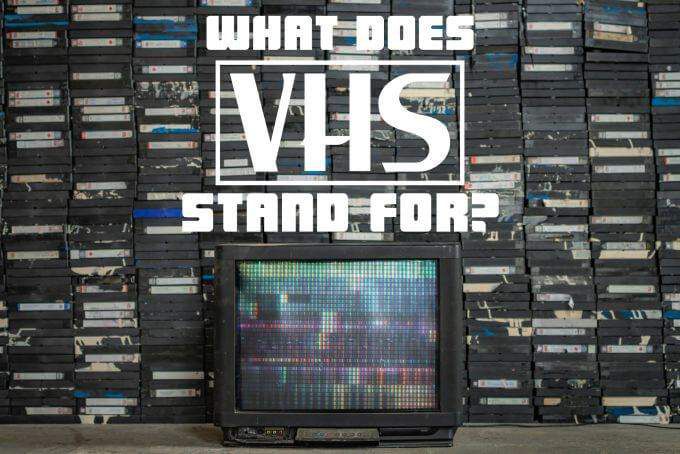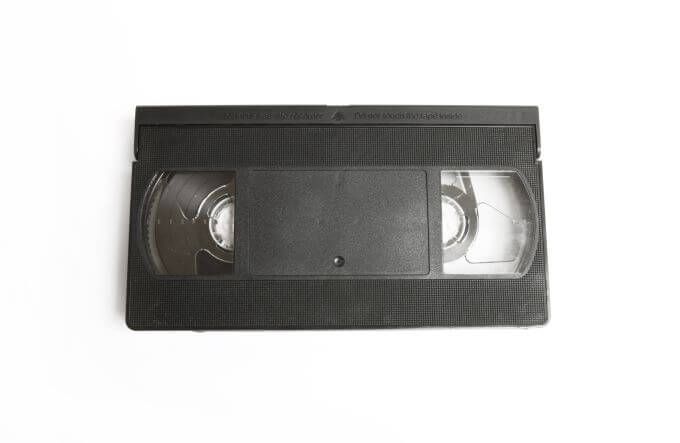Now that streaming services have become the standard route of entertainment consumption, long gone are the days of physical media. Shelves full of movies have all been replaced by shiny new streaming devices.
This is not a new phenomena. Just as these devices have replaced DVDs and Blu-Rays, so too did DVDs replace the VHS tape. This home movie format has become so obsolete that you may not even know, or remember, what the term VHS means. Or, how VHS tapes came to be in the first place.


What Does “VHS” Stand For?
VHS stands for Video Home System. The main selling point of the VHS tape was that it allowed television viewers to record shows onto these tapes at home. The format was released in the U.S. by the company JVC in 1977, and first released in Japan in 1976.
At the time, another home video format called Betamax, created by Sony, was at the forefront of most home video consumption. But VHS grew astronomically, and by 1980, the VHS format had control over 60% of the home video market in North America.


The contention points between Betamax and VHS that helped the latter gain popularity was recording time, as well as the lower cost of VHS-based VCRs (video-cassette recorders). This allowed consumers to record full-length movies and more TV episodes on one tape, a very alluring feature over the Betamax, which could only record up to an hour at the time.
How Does a VHS Tape Work?
Once JVC licensed the VHS format to multiple other companies, many of them began to make VHS players. This is why you can find so many different models of VCRs. A lot of them have differing features, depending on the brand and when they were released, but they all generally worked the same way. So what was the technology behind the VHS tape and VCR that inevitably led to its dominance in the market?


The video would first be recorded on the 800-foot long, half-inch wide magnetic tape, wound around the two spools inside the case. Inside the cassette are some rollers that move the video tape around to the edge, which is covered by a spring-loaded door so it doesn’t get ruined by regular handling.
When placed inside a VCR, the machine opens this door to use the tape. It uses a motorized mechanism to move the tape over the playback head, using helical scanning to read what’s on the tape and send signals to the TV. The TV then displays this information as video and audio.


The VHS and VCR enjoyed a lengthy stay at the top of consumer preference. The format lasted for over 20 years, until it began to get phased out in 1997 due to the rise of the DVD format.
The Decline of the VHS Tape
In June 2003, the number of DVD rentals in the U.S. overcame VHS rentals for the first time, by 900,000. Since that time, the decline in popularity of the VHS format was steady.
Shortly after this, many retail stores stopped selling VCRs. It was only a matter of time before you could only find DVD players and DVD movies stocked on store shelves. This included home video rental stores, such as Blockbuster, now a relic of the past.


The DVD-VHS battle gave rise to some combination video players which could support both formats. Despite VHS losing revenue in the mid-2000’s, over 94 million Americans still owned some sort of VHS player. Slowly, however, DVD became the preferred format, as well as its rival, the Blu-Ray.
Then, when streaming services later made watching movies and TV shows even easier and more affordable, VHS was even further pushed out of the picture. The same happened with DVDs, and video rental stores began to run bankrupt. Physical media was no longer preferred.
Differences Between VHS and Modern Formats
Is it even still worth it to own VHS tapes? It depends on what you’re looking for in your entertainment experience.
The most obvious difference between VHS and digital formats is quality. You can easily get better video quality in DVDs, Blu-Rays, and streaming devices than you could ever squeeze out of a VHS. Though, for some, the noisy and grainy picture produced by the format has some nostalgic charm.


You could certainly argue for the cheapness of VHS nowadays. Since it has become so obsolete, people are getting rid of their VCRs for next to nothing, and you can find VHS tapes for pennies or completely free.
For the video enthusiast, VHS tapes are an almost free gold mine of movies, shows, and programs, especially those obscure ones that never made it over to a digital format. And, unlike streaming services that cycle through their titles every few weeks, you’ll always have your favorites around whenever you want them.
The VHS and Beyond
You might have forgotten all about the VHS, and weekend trips to the video store that was flocked to by people of every age. At that time, you had to pick one or two movies to rent or buy because that was the most affordable option.


These days, we’re spoiled for choice, with hundreds of titles available at our fingertips for small monthly fees. Now that the average American has a subscription to at least three different streaming services, and streams about eight hours of content daily, there are tons of devices to choose from that offer hundreds of streaming platforms. At times, it can feel overwhelming.
So the next time you’re fruitlessly scrolling through Netflix or Hulu trying to find something to watch, it may be helpful to remember the humble beginnings of home video as we know it.

